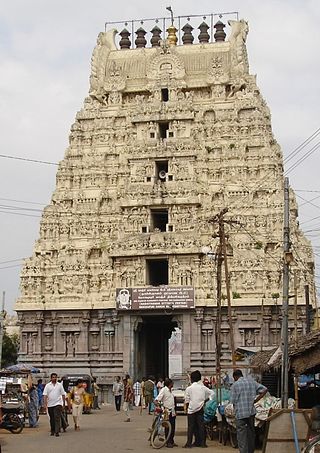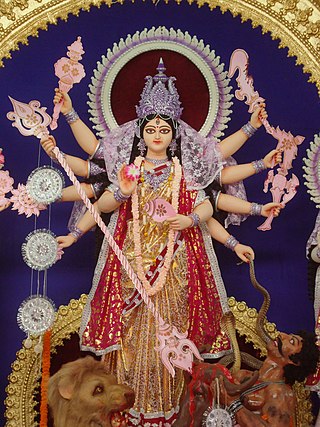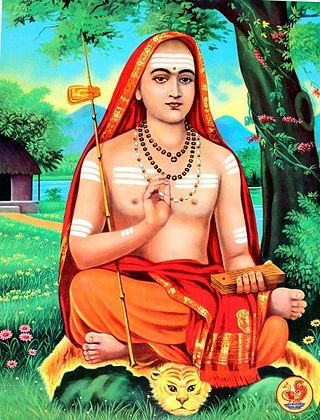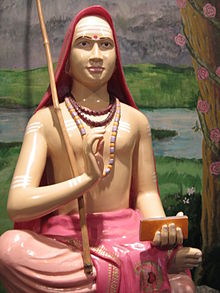
Lakshmi also known as Shri, is one of the principal goddesses in Hinduism. She is the goddess of wealth, fortune, power, beauty, fertility and prosperity, and associated with Maya ("Illusion"). Along with Parvati and Saraswati, she forms the Tridevi of Hindu goddesses.

The Vishnu Sahasranama, is a Sanskrit hymn containing a list of the 1,000 names of Vishnu, one of the main deities in Hinduism and the Supreme God in Vaishnavism. It is one of the most sacred and popular stotras in Hinduism. The most popular version of the Vishnu Sahasranama is featured in the Anushasana Parva of the epic Mahabharata. Other versions exist in the Padma Purana, the Skanda Purana, and the Garuda Purana. There is also a Sikh version of the Vishnu Sahasranama found in the work Sundar Gutka.

Mahishasura is a bovine asura in Hinduism. He is depicted in Hindu literature as a deceitful demon who pursued his evil ways by shape-shifting. Mahishasura was the son of the asura Rambha and a she-buffalo named Mahisi. He was ultimately killed by the goddess Durga with her trishula (trident) after which she gained the epithet Mahishasuramardini. Mahishasura had a son named Gajasura.

Bhaja Govindam, also known as Moha Mudgara, is a popular Hindu devotional poem in Sanskrit composed by Adi Shankara. This work of Adi Shankara underscores the view that bhakti (devotion) is also important along with jñāna (knowledge), as emphasised by the Bhakti movement.
Kalady or Kaladi is a town located between Angamaly and Perumbavoor, east of the Periyar river, near to Malayattoor in Ernakulam district of Kerala, India, not far from Cochin International Airport. It is notable as the birthplace of 9th century Indian philosopher Adi Shankara.

Tripura Sundari, also known as Rajarajeshvari, Shodashi, Kamakshi, and Lalita, is a Hindu goddess, revered primarily within the Shaktism tradition and recognized as one of the ten Mahavidyas. She embodies the essence of the supreme goddess Mahadevi. Central to the Shakta texts, she is widely praised in the Lalita Sahasranama and Saundarya Lahari. In the Lalitopakhyana of the Brahmanda Purana, she is referred to as Adi Parashakti.

The Kamakshi Amman Temple, also known as Kamakoti Nayaki Kovil, is a Hindu temple dedicated to the goddess Kamakshi, one of the highest aspects of Adi Parashakti, the supreme goddess in Shaktism. The temple is located in the historic city of Kanchipuram, near Chennai, India.

The Shivananda Lahari is a devotional hymn composed by Adi Shankara, an Advaita philosopher, on Shiva. It literally means, "wave of auspicious bliss". It consists of one hundred stanzas of Sanskrit poetry in various chandas (metres). It was composed by Adi Shankara while staying in Srisailam, a pilgrimage town, in Kurnool district of Andhra Pradesh. It begins with an ode to Mallikarjuna and Bhramarambika, the deities at Srisailam.
Adi Shankara, a Hindu philosopher of the Advaita Vedanta school, composed a number of commentarial works. Due to his later influence, a large body of works that is central to the Advaita Vedanta interpretation of the Prasthanatrayi, the canonical texts consisting of the Upanishads, the Bhagavad Gita and the Brahma Sutras, is also attributed to him. While his own works mainly consist of commentaries, the later works summarize various doctrines of the Advaita Vedanta tradition, including doctrines that diverge from those of Adi Shankara.

Sri Sharadamba Temple is a famous Hindu temple dedicated to goddess Sharadamba in the holy town of Sringeri in Karnataka, India.

The Shri Sukta(Sanskrit: श्रीसूक्तम्, romanized: Śrīsūktam), also called the Shri Suktam, is the earliest recorded Sanskrit devotional hymns that revere Shri-Lakshmi, the Hindu goddess of wealth, prosperity, and fertility. The Shri Sukta is recited, with a strict adherence to Sanskrit prosody for the veneration of the goddess. This hymn is found in the Rigvedic khilanis, which are appendices to the Rigveda that can be dated back to the pre-Buddhist era.
The roots of Shaktism – a Hindu denomination that focuses worship upon Shakti or Devi, the Hindu Divine Mother – penetrate deeply into India's prehistory. The Devi's earliest known appearance in Indian Paleolithic settlements is believed to go back more than 8000 years ago.

Ashta Lakshmi or Ashtalakshmi, is a group of the eight manifestations of Lakshmi, the Hindu goddess of prosperity. She presides over eight sources of wealth: spirituality, material wealth, agriculture, royalty, knowledge, courage, progeny, and victory.

Shakti is the fundamental cosmic energy and a central deity within Shaktism, a significant theological tradition of Hinduism. Representing dynamic forces that permeate the universe, Shakti embodies feminine energy and is often depicted as the consort of Shiva. In this tradition, Devi, the Goddess, is regarded as the Supreme Brahman herself, with all other divine forms seen as her manifestations. The worship of Shakti entails a diverse array of goddesses, including Durga, Kali, Parvati, and Tripura Sundari, each representing unique facets of her power.

The Shiva Panchakshara Stotra is a Hindu religious hymn (stotra) dedicated to god Shiva. Comprising five stanzas, it is regarded to have been composed by the philosopher Adi Shankara.

The Sri Stuti is a Sanskrit hymn written by the Hindu philosopher Vedanta Desika. Comprising 25 verses, the work is an ode to the goddess Lakshmi (Sri).

The Ashtalakshmi Stotra, also rendered the Ashta Lakshmi Stotram, is a Hindu mantra. It extols the eight aspects of the goddess Lakshmi, designated as the Ashta Lakshmi, regarded to represent the eight forms of wealth.

The Mahishasura Mardini Stotra is a Hindu stotra. Comprising 21 verses, the work extols the goddess Durga, a principal aspect of the supreme goddess Mahadevi, and her act of slaying the asura Mahishasura.

The Dasha Shloki is a Sanskrit hymn by the Hindu philosopher Adi Shankara. Comprising ten verses, the Dasha Shloki explores the Brahman-Atman relationship and the author's interpretation of the nature of the self.

The Annapurna Stotra is a Hindu stotra written by the philosopher Adi Shankara. Comprising 12 verses, the work extols the goddess Annapurna, an aspect of the goddess Parvati.















